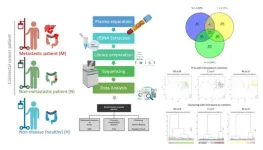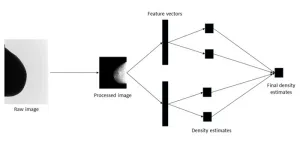(Press-News.org) By using precision gene engineering techniques, researchers at the Earlham Institute in Norwich have been able to turn tobacco plants into solar-powered factories for moth sex pheromones.
Critically, they’ve shown how the production of these molecules can be efficiently managed so as not to hamper normal plant growth.
Pheromones are complex chemicals produced and released by an organism as a means of communication. They allow members of the same species to send signals, which includes letting others know they’re looking for love.
Farmers can hang pheromone dispersers among their crops to mimic the signals of female insects, trapping or distracting the males from finding a mate. Some of these molecules can be produced by chemical processes but chemical synthesis is often expensive and creates toxic byproducts.
Dr Nicola Patron, who led this new research and heads the Synthetic Biology Group at the Earlham Institute, uses cutting-edge science to get plants to produce these valuable natural products.
Synthetic biology applies engineering principles to the building blocks of life, DNA. By creating genetic modules with the instructions to build new molecules, Dr Patron and her group can turn a plant such as tobacco into a factory that only needs sunlight and water.
“Synthetic biology can allow us to engineer plants to make a lot more of something they already produced, or we can provide the genetic instructions that allow them to build new biological molecules, such as medicines or these pheromones,” said Dr Patron.
In this latest work, the team worked with scientists at the Plant Molecular and Cell Biology Institute in Valencia to engineer a species of tobacco, Nicotiana benthamiana, to produce moth sex pheromones. The same plant has previously been engineered to produce ebola antibodies and even coronavirus-like particles for use in Covid vaccines.
The Group built new sequences of DNA in the lab to mimic the moth genes and introduced a few molecular switches to precisely regulate their expression, which effectively turns the manufacturing process on and off.
An important component of the new research was the ability to fine tune the production of the pheromones, as coercing plants to continuously build these molecules has its drawbacks.
“As we increase the efficiency, too much energy is diverted away from normal growth and development,” explained Dr Patron.
“The plants are producing a lot of pheromone but they’re not able to grow very large, which essentially reduces the capacity of our production line. Our new research provides a way to regulate gene expression with much more subtlety.”
In the lab, the team set about testing and refining the control of genes responsible for producing the mix of specific molecules that mimic the sex pheromones of moth species, including navel orangeworm and cotton bollworm moths.
They showed that copper sulphate could be used to finely tune the activity of the genes, allowing them to control both the timing and level of gene expression. This is particularly important as copper sulphate is a cheap and readily-available compound already approved for use in agriculture.
They were even able to carefully control the production of different pheromone components, allowing them to tweak the cocktail to better suit specific moth species.
“We’ve shown we can control the levels of expression of each gene relative to the others,” said Dr Patron. “This allows us to control the ratio of products that are made.
“Getting that recipe right is particularly important for moth pheromones as they’re often a blend of two or three molecules in specific ratios. Our collaborators in Spain are now extracting the plant-made pheromones and testing them in dispensers to see how well they compare to female moths.”
The team hope their work will pave the way to routinely using plants to produce a wide range of valuable natural products.
“A major advantage of using plants is that it can be far more expensive to build complex molecules using chemical processes,” said Dr Patron. “Plants produce an array of useful molecules already so we’re able to use the latest techniques to adapt and refine the existing machinery.
“In the future, we may see greenhouses full of plant factories - providing a greener, cheaper and more sustainable way to manufacture complex molecules.”
The research is part of the SUSPHIRE project, which received support from ERACoBiotech funded by the Horizon 2020 research and innovation program and the UKRI Biotechnology and Biological Sciences Research Council (BBSRC).
ENDS
Notes to Editor
'Tunable control of insect pheromone biosynthesis in Nicotiana benthamiana' is published in the journal Plant Biotechnology.
The plants in this research are not designed for consumption or field growth. The intention of this project has been for biosynthesised pheromones to be extracted from plants grown in a contained environment, with the extracts used in the same way as chemically synthesised pheromone products. The biosynthesised pheromones are not volatile or released into the air by the plant.
END
**Note: the release below is a special early release from the European Congress of Clinical Microbiology & Infectious Diseases (ECCMID 2023, Copenhagen, 15-18 April). Please credit the conference if you use this story**
Embargo: 2301H UK time Friday 7 April
New research being presented at this year’s European Congress of Clinical Microbiology & Infectious Diseases (ECCMID) in Copenhagen, Denmark, (15-18 April) has identified several gold-based compounds with the potential to treat multidrug-resistant “superbugs”.
With ...
It feels like a classical paradox: How do you see the invisible? But for modern astronomers, it is a very real challenge: How do you measure dark matter, which by definition emits no light?
The answer: You see how it impacts things that you can see. In the case of dark matter, astronomers watch how light from distant galaxies bends around it.
An international team of astrophysicists and cosmologists have spent the past year teasing out the secrets of this elusive material, using sophisticated computer simulations and the observations from the one of the most powerful astronomical cameras in the world, the Hyper Suprime-Cam (HSC). The team is led by astronomers from Princeton ...
People with autism spectrum disorder can be classified into four distinct subtypes based on their brain activity and behavior, according to a study from Weill Cornell Medicine investigators.
The study, published March 9 in Nature Neuroscience, leveraged machine learning to analyze newly available neuroimaging data from 299 people with autism and 907 neurotypical people. They found patterns of brain connections linked with behavioral traits in people with autism, such as verbal ability, social affect, and repetitive or stereotypic behaviors. They confirmed that the four autism subgroups could also be replicated in a separate dataset ...
“[...] DPE analysis may have an important role in improving the diagnosis and management of CRC.”
BUFFALO, NY- April 7, 2023 – A new editorial paper was published in Oncoscience (Volume 10) on March 23, 2023, entitled, “New method of clustering colorectal cancer patients using differential presence of exons (DPE) sequencing.”
Colorectal cancer (CRC) is a heterogeneous disease that occurs in the colon and the rectum, parts of the gastrointestinal system. CRC is the third leading cause of cancer-related ...
Breast cancer is the most common cancer to affect women worldwide. According to the American Cancer Society, about 1 in 8 women in the United States will develop breast cancer in their lifetime. While it is not possible to entirely prevent breast cancer, various medical organizations advise regular screening to detect and treat cases at the early stage. The breast density, defined as the proportion of fibro-glandular tissue within the breast, is often used to assess the risk of developing breast cancer. While various methods are available to estimate this measure, studies have shown that subjective assessments conducted by radiologists based on visual analogue scales ...
Lesbian, gay, bisexual, transgender and queer people who experienced intimate partner violence in their current relationship before COVID-19 had an increase in the frequency of victimization after the pandemic began, according to a Rutgers study.
While national emergencies, crises and pandemics increase the frequency of health risks and intimate partner violence few studies have considered the nuances of social and psychological factors, such as socioeconomic characteristics and mental health, in explaining the increase in intimate partner violence during times of crisis.
“To date, most programs on intimate ...
Irvine, Calif., April 7, 2023 — Human activities emit many kinds of pollutants into the air, and without a molecule called hydroxide (OH), many of these pollutants would keep aggregating in the atmosphere.
How OH itself forms in the atmosphere was viewed as a complete story, but in new research published in Proceedings of the National Academy of Sciences, a research team that includes Sergey Nizkorodov, a University of California, Irvine professor of chemistry, report that a strong electric field that exists at the surface between airborne water droplets and ...
The explosion of a star is a dramatic event, but the remains the star leaves behind can be even more dramatic. A new mid-infrared image from NASA’s James Webb Space Telescope provides one stunning example. It shows the supernova remnant Cassiopeia A (Cas A), created by a stellar explosion seen from Earth 340 years ago. Cas A is the youngest known remnant from an exploding, massive star in our galaxy, which makes it a unique opportunity to learn more about how such supernovae occur.
“Cas ...
If you know the atoms that compose a particular molecule or solid material, the interactions between those atoms can be determined computationally, by solving quantum mechanical equations — at least, if the molecule is small and simple. However, solving these equations, critical for fields from materials engineering to drug design, requires a prohibitively long computational time for complex molecules and materials.
Now, researchers at the U.S. Department of Energy’s (DOE) Argonne National Laboratory and the University of Chicago’s ...
On January 6, 2021, the public watched in disbelief as the Capitol building was stormed by hundreds of protestors. Most spectators at home didn't know violence at the Capitol building was already circulating through far-right social media channels for months.
Social media, for better or worse, play a large role in how we consume information – as well as spreading misinformation and conspiratorial propaganda.
Researchers at the University of Pittsburgh received $100,000 as part of the Meta Foundational Integrity Research ...




